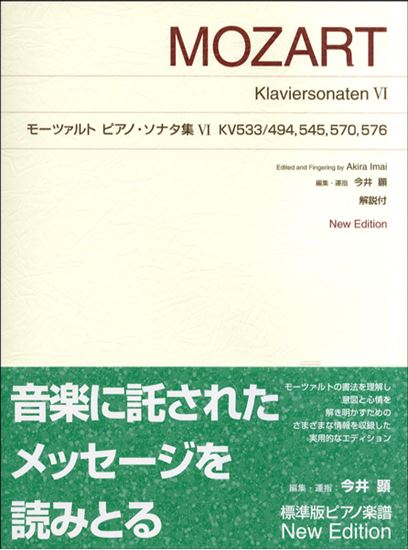Mozart, Wolfgang Amadeus : Sonate für Klavier Nr.17 D-Dur K.576
Work Overview
Publication Year:1805
First Publisher:Bureau d'arts et d'industrie
Instrumentation:Piano Solo
Genre:sonata
Total Playing Time:13 min 30 sec
Copyright:Public Domain
Additional Notes:新モーツァルト全集では、ソナタ番号が旧来の「17番」から「18番」へと変更された。
Commentary (1)
Author : Okada, Akihiro
Last Updated: December 1, 2009
[Open]
Author : Okada, Akihiro
Mozart's own "Catalogue of Works" records "Sonata for Clavier" with the date July 1789, making it his last completed clavier sonata. Previously, it was believed to have been commissioned by Frederick William II, whom Mozart met during his North German journey, and composed for Princess Friederike. However, this theory has been questioned in recent years. The first edition was published posthumously in 1805 by Kunst- und Industrie-Comptoir in Vienna, but the autograph manuscript has been lost.
First Movement: D major, 6/8 time, Sonata Form
The principal theme begins with an arpeggiated motif reminiscent of a horn call, immediately repeated a second higher. The theme is then confirmed (m. 9–) in the bass, while the upper voice presents a passage of sixteenth notes. The transition consists of two parts: first, a section with sixteenth-note passages (m. 16–), followed by a confirming transition (m. 28–) in the dominant key of A major, where the horn-call motif of the principal theme appears with imitation delayed by one beat (canon at the octave).
After a perfect cadence in the dominant, a cantabile secondary theme appears (m. 42–). After being confirmed with variations, it leads to a short coda, concluding with a signal-like motif (m. 57).
The second half (m. 59–) begins with the signal-like motif that appeared at the end of the coda, and the principal theme immediately appears in B-flat major. With imitation delayed by one measure (canon at the octave), it modulates to G minor, then develops with imitation delayed by half a measure (three beats).
Through passages of sixteenth notes, passing through A minor and B minor, the signal motif reappears (m. 81–). This motif is repeated sequentially, moving from B minor to E minor, A minor, and then, reminiscent of D minor, finally arriving at the tonic D major.
From the sixteenth-note passage, it seamlessly connects to the recapitulation of the principal theme (m. 99–). The transition is modified, and the motif that appeared in the upper voice during the confirmation of the principal theme develops in a responsorial manner (m. 112–). Immediately thereafter, the secondary theme is recapitulated in the tonic (m. 122–), followed by the imitative development of the principal theme, which had served as a confirming transition in the first half. Although the structure might be mistaken for a large-scale coda, the movement concludes with a coda similar to that of the first half (m. 155–).
Second Movement: A major, 3/4 time
Throughout the movement, a three-voice texture is fundamental. Considering Mozart's deep inclination towards Baroque music at the time, this could be described as trio sonata-like.
It consists of a theme in A major with figural ornamentation, and a section (m. 17–) characterized by ornamentation on A in the parallel minor, F-sharp minor, and includes an improvisatory section with thirty-second note passages (m. 24–). The F-sharp minor theme reappears (m. 32–), and after an improvisatory transition, the opening theme returns (m. 44–). Finally, the minor theme appears in a transposed form in the tonic A major.
Third Movement: D major, 2/4 time, Rondo-Sonata Form
The rondo theme has a dance-like character and is presented with a simple accompaniment of chordal pulsations, but the accompanying voice quickly transforms into a virtuosic passage of sixteenth-note triplets. These sixteenth-note triplets transform into arpeggios, becoming a central structural element of the piece.
It modulates to the dominant, and the rondo theme's motif develops in a responsorial manner (m. 26–). After an intervening transitional passage of sixteenth-note triplets, a harmonic couplet theme characterized by stepwise descent is presented (m. 51–). Then, after a transition of ascending and descending arpeggios in sixteenth-note triplets, the opening theme returns (m. 65–), and the transition is modified, leading to F major.
The middle section develops the opening theme's motif and unfolds polyphonically. It progresses from F major through G minor, A minor, B minor, and E minor, arriving at D major and a half cadence.
The responsorial idea based on the opening motif, which introduced the dominant theme in the first half, appears in the tonic, and the couplet theme is recapitulated in the tonic (m. 142–). After a transition of arpeggios in sixteenth-note triplets, the rondo theme returns, concluding the piece.
The third movement, with its developmental middle section and the recapitulation of the couplet theme in the tonic, can be described as a rondo form with sonata-form-like tonal organization and motivic development.
Sonata K. 576 stands out among all of Mozart's clavier sonatas, as its outer movements emphasize polyphonic development and motivic elaboration.
Movements (3)
PTNA & Partner Channel Videos(8items)
Reference Videos & Audition Selections(6items)
Sheet Music
Scores List (13)

(株)全音楽譜出版社

(株)全音楽譜出版社

(株)全音楽譜出版社

(株)全音楽譜出版社

(株)音楽之友社

(株)全音楽譜出版社

(株)ヤマハミュージックエンタテインメントホールディングス

(株)音楽之友社

















